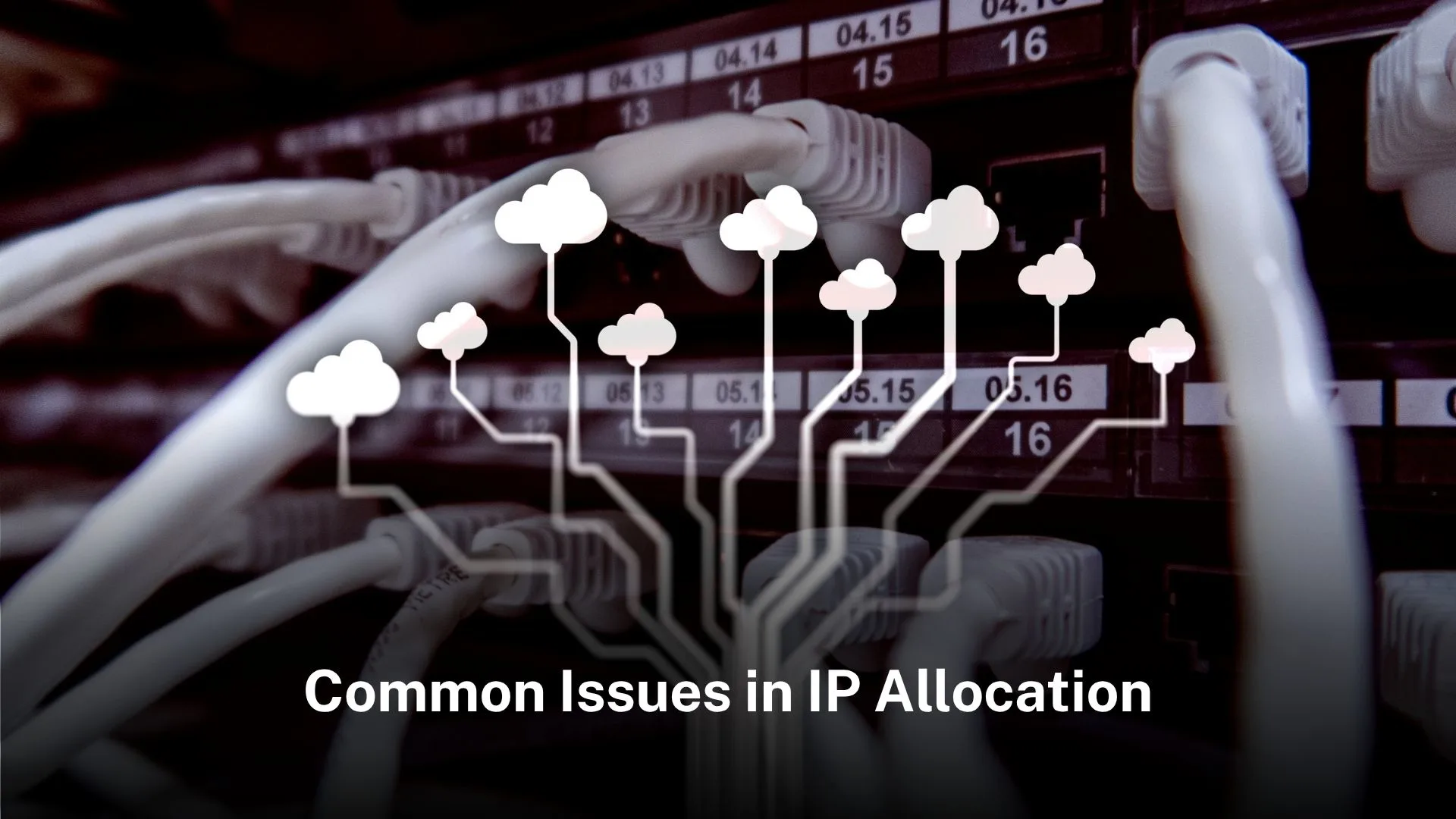Explore the key challenges in IP address allocation, including IPv4 exhaustion, slow IPv6 adoption, and inefficient allocation practices.
Table of Contents
ToggleIntroduction
The allocation of IP addresses is a basic part of the Internet infrastructure, necessary to allow devices to talk to one another. Every internet-connected device, whether a smartphone or a server, requires a unique IP address to get and send its data. Good allocation can translate into slightly less crashing and slower degradation when networks get overloaded. The expansion of the Internet over the past decades has resulted in a growing demand for addresses, and so there more than ever needs to be careful management. Regional Internet Registries (RIRs) such as LACNIC, APNIC, ARIN, RIPE NCC and AFRINIC are the entities responsible with the distribution of IP address and the ASNs in the global regions, while the local Internet registry (LIR) is answerable for the distribution at the national level. Their procedures and policies are well-defined, ensuring that there is a renumeration that is fair to all the networks without leading to any kind of network conflict.
With time, many problems have been raised concerning the distribution and utilization of IP addresses efficiently. Among the more pressing issues is the depletion of the IPv4 pool of addresses, and the subsequent reliance on temporary solutions such as Network Address Translation (NAT) and address sharing. Another challenge is slow adoption of IPv6, the new protocol with a larger address space and more flexible routing capabilities. When even when IPv6 is an option, some networks simply don’t want to make the single jump due to infrastructure investments, lack of technical know-how, and fears of how their applications will fare. Poorly efficient allocation strategies in the early days of the internet still continue to affect how things are run now too, as large blocks of addresses were assigned with little forethought about how many would be used, leaving many resources underutilised.
These issues are not only technical, but are operational and economic factors impacting investments in either network expansion or service delivery. They impact the scalability of networks, adding new users, and the overall stability of the internet. As John Curran, CEO of ARIN, stated, “IP address management is a critical part of internet growth and stability. Poor allocation slows development and increases operational risk.” These matters need to be handled in a conductive manner, and coordinated between RIR, ISP, government, and technical community, so that IP resource management is fair and equitable and sustainable.
The introduction of IPv6 and contemporary allocation methodologies alleviated some of the difficulties, however there are still issues, particularly in regions where demand for addresses is growing. Education, policies, and more regional cooperation are needed if networks are going to be capable of scaling safely and if the Internet is going to remain as open and accessible to all as it always has been. To that end, an understanding of the concerns related to IP addresses is relevant for policymakers, network operators, and any other stakeholders in the future of the global internet infrastructure.
IPv4 Exhaustion
IPv4, the fourth version of the Internet Protocol, has been the backbone of internet addressing since its inception. With a 32-bit address space, it offers approximately 4.3 billion unique addresses. As the internet grew exponentially, this pool became insufficient. The exhaustion of IPv4 addresses has been a significant concern, leading to the need for alternative solutions.
The depletion of IPv4 addresses has led to the implementation of various strategies to manage the limited resource. Techniques such as Network Address Translation (NAT) and Classless Inter-Domain Routing (CIDR) have been employed to extend the usability of existing addresses. However, these methods are not without their drawbacks and do not provide a long-term solution to the problem.
Slow Adoption of IPv6
IPv6 was developed as a solution to the depletion of IPv4 addresses and hence provides a much larger address space. However, adoption of IPv6 is slow. There are a number of reasons for this delay, including the cost of upgrading infrastructure, the lack of immediate benefits, and compatibility issues with current systems.
The gradual deployment of IPv6 challenges the scalability of the Internet. With more and more devices connecting to the Internet, the need for IP addresses is growing. Without switching to IPv6, the shortcomings of IPv4 will be more and more exposed, perhaps even limiting the growth of the internet.
Inefficient Allocation Practices
Poor distribution method has also compounded the problem in the IP address distribution. Traditional allocation resulted in many organizations being assigned large blocks of IP addresses that were never fully utilized. This wastefulness has created a shortage of free addresses making allocation even more difficult.
Correcting these inefficiencies calls for reexamining the allocation methods. Stronger policies and incentives to reclaim unused addresses could be introduced to better utilize available resources. Encouraging organizations to switch to IPv6 can also relieve pressure on the IPv4 address pool.
Regional Disparities in Address Allocation
There are vast differences between regions on allocations of IP addresses. Some are empty of IPv4 addresses, others not. This disparity may create challenges for the equally-layered access and development of the Internet, as the tienes regions may be hindered in their network growth.
Such discrepancies are to be remedied through the promotion of IPv6 deployment and through the introduction of policies to maximize the use of the available addresses. Global cooperation and regional internet registry coordination will be needed to ensure that IP addresses are distributed fairly and are accessible.
The Role of Internet Service Providers (ISPs)
ISP are essential in the distribution of IP addresses, and subsequently they are the ones who have the IP addresses which are then assigned to end users. They assign IP addresses to their customers and manage the networks to which those IP addresses are associated. ISPs behavior may have a large impact on address distribution efficiency.
ISPs may also help address the problem of allocation by applying good practice in managing addresses. Such efforts include reclaiming unused addresses, advocating the use of IPv6, and informing customers of the benefits of using addresses efficiently. In this case, they can help offset some of the pain of IP address allocation, if they act.
Emerging Solutions and Future Directions
There are multiple proposals to solve the problem of IP address allocation. The widespread use of IPv6 is considered the only option for solving the problem of IPv4 exhaustion.
Organizations are advised to operate dual-stack networks until such time as IPv6 is the norm. Address reclamation policies can also reclaim dormant blocks of IPv4. Fair sharing of address resources is ensured through regional collaboration. RIRs continue to offer advice and training as well as policy frameworks that enable organizations to continue to make efficient use of their allocations. Professionals emphasize that the resolution of IP allocation issues will be vital for the future expansion of the internet.
FAQs
1. What is IPv4 exhaustion?
IPv4 exhaustion is the depletion of available IPv4 addresses, limiting new network growth.
2. Why is IPv6 adoption slow?
IPv6 adoption is slow due to costs, infrastructure changes, and compatibility concerns.
3. How can inefficient IP allocation be fixed?
Inefficient allocation can be improved by reclaiming unused addresses and applying stricter policies.
4. What are regional disparities in IP allocation?
Some regions have few IPv4 addresses left while others still have resources, creating uneven access.
5. How do ISPs influence IP allocation?
ISPs assign addresses to users and manage networks. Their practices affect efficiency and security.




